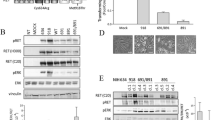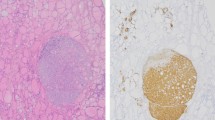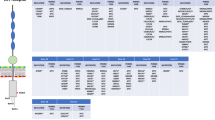Abstract
Activating germline mutations in the RET proto-oncogene are responsible for about 98 % of the familial forms of medullary thyroid carcinoma (MTC), which represent 25 % of all MTC cases. The search for germline mutations in this gene is important for the recognition of hereditary forms of MTC and further identification of at-risk relatives who may benefit from early clinical intervention. Genotype–phenotype correlations are well established for most disease-causing RET mutations, allowing risk stratification. The association of a new RET variant with the MTC phenotype and familial predisposition requires the assessment of its functional and clinical significance. The aim of this study was to evaluate the oncogenic potential of two newly identified RET germline variants associated with late-onset MTC. In vitro functional assays were designed to address the transforming potential of novel RET variants, through their expression in non-transformed cells, and comparing their effect with wild-type RET. The new variants were identified in codons 515 (p.C515W) and 636 (p.T636M) located, respectively, in exons 8 and 11, thus resulting in amino acid substitutions in the extracellular region of the tyrosine kinase receptor RET. Through functional assays, we observed increased cell growth and proliferation, loss of contact inhibition, and a stimulation of cell migration, suggesting that these new RET variants hold some relevant transforming potential. The transforming potential of these novel RET variants was of low-grade, when compared to that of RET MEN2A-causing mutation p.C634R, probably explaining the mild phenotype characterized by late onset and low clinical aggressiveness.


Similar content being viewed by others
References
A. Cerrato, V. De Falco, M. Santoro, Molecular genetics of medullary thyroid carcinoma: the quest for novel therapeutic targets. J. Mol. Endocrinol. 43, 143–155 (2009)
F.D. Gilliland, W.C. Hunt, D.M. Morris, C.R. Key, Prognostic factors for thyroid carcinoma. A population-based study of 15,698 cases from the Surveillance, Epidemiology and End Results (SEER) program 1973–1991. Cancer 79, 564–573 (1997)
R.A. DeLellis, Pathology and genetics of thyroid carcinoma. J. Surg. Oncol. 94, 662–669 (2006)
C. Eng, D. Clayton, I. Schuffenecker, G. Lenoir, G. Cote, R.F. Gagel, H.K. van Amstel, C.J. Lips, I. Nishisho, S.I. Takai, D.J. Marsh, B.G. Robinson, K. Frank-Raue, F. Raue, F. Xue, W.W. Noll, C. Romei, F. Pacini, M. Fink, B. Niederle, J. Zedenius, M. Nordenskjöld, P. Komminoth, G.N. Hendy, L.M. Mulligan, The relationship between specific RET proto-oncogene mutations and disease phenotype in multiple endocrine neoplasia type 2. International RET mutation consortium analysis. JAMA 276, 1575–1579 (1996)
L.M. Mulligan, C. Eng, C.S. Healey, D. Clayton, J.B. Kwok, E. Gardner, M.A. Ponder, A. Frilling, C.E. Jackson, H. Lehnert, Specific mutations of the RET proto-oncogene are related to disease phenotype in MEN 2A and FMTC. Nat. Genet. 6, 70–74 (1994)
L.M. Mulligan, D.J. Marsh, B.G. Robinson, I. Schuffenecker, J. Zedenius, C.J. Lips, R.F. Gagel, S.I. Takai, W.W. Noll, M. Fink, Genotype–phenotype correlation in multiple endocrine neoplasia type 2: report of the International RET Mutation Consortium. J. Intern. Med. 238, 343–346 (1995)
E. Arighi, M.G. Borrello, H. Sariola, RET tyrosine kinase signaling in development and cancer. Cytokine Growth Factor Rev. 16, 441–467 (2005)
J.E. Phay, M.H. Shah, Targeting RET receptor tyrosine kinase activation in cancer. Clin. Cancer Res. 16, 5936–5941 (2010)
G. Figlioli, S. Landi, C. Romei, R. Elisei, F. Gemignani, Medullary thyroid carcinoma (MTC) and RET proto-oncogene: mutation spectrum in the familial cases and a meta-analysis of studies on the sporadic form. Mutat. Res. 752, 36–44 (2013)
M.M. Moura, B.M. Cavaco, A.E. Pinto, R. Domingues, J.R. Santos, M.O. Cid, M.J. Bugalho, V. Leite, Correlation of RET somatic mutations with clinicopathological features in sporadic medullary thyroid carcinomas. Br. J. Cancer 100, 1777–1783 (2009)
T. Fukuda, K. Kiuchi, M. Takahashi, Novel mechanism of regulation of Rac activity and lamellipodia formation by RET tyrosine kinase. J. Biol. Chem. 277, 19114–19121 (2002)
W.-H. Hsu, Y.-R. Yu, S.-H. Hsu, W.-C. Yu, Y.-H. Chu, Y.-J. Chen, C.-M. Chen, L.-R. You, The Wilms’ tumor suppressor Wt1 regulates Coronin 1B expression in the epicardium. Exp. Cell Res. 319, 1365–1381 (2013)
T.H.-Y. Leung, Y.-P. Ching, J.W.P. Yam, C.-M. Wong, T.-O. Yau, D.-Y. Jin, I.O.-L. Ng, Deleted in liver cancer 2 (DLC2) suppresses cell transformation by means of inhibition of RhoA activity. Proc. Natl. Acad. Sci. U.S.A. 102, 15207–15212 (2005)
P. Matos, C. Oliveira, S. Velho, V. Gonçalves, L.T. da Costa, M.P. Moyer, R. Seruca, P. Jordan, B-Raf(V600E) cooperates with alternative spliced Rac1b to sustain colorectal cancer cell survival. Gastroenterology 135, 899–906 (2008)
H. Prazeres, J.P. Couto, F. Rodrigues, J. Vinagre, J. Torres, V. Trovisco, T.C. Martins, M. Sobrinho-Simões, P. Soares, In vitro transforming potential, intracellular signaling properties, and sensitivity to a kinase inhibitor (sorafenib) of RET proto-oncogene variants Glu511Lys, Ser649Leu, and Arg886Trp. Endocr. Relat. Cancer 18, 401–412 (2011)
R.A. Toledo, R. Hatakana, D.M. Lourenço, S.C. Lindsey, C.P. Camacho, M. Almeida, J.V. Lima, T. Sekiya, E. Garralda, M.S. Naslavsky, G.L. Yamamoto, M. Lazar, O. Meirelles, T.J.P. Sobreira, M.L. Lebrao, Y.A.O. Duarte, J. Blangero, M. Zatz, J.M. Cerutti, R.M.B. Maciel, S.P.A. Toledo, Comprehensive assessment of the disputed RET Y791F variant shows no association with medullary thyroid carcinoma susceptibility. Endocr. Relat. Cancer 22, 65–76 (2015)
C.F. Ibáñez, Structure and physiology of the RET receptor tyrosine kinase. Cold Spring Harb. Perspect. Biol. 5, a009134 (2013)
S.M. Wagner, S. Zhu, A.C. Nicolescu, L.M. Mulligan, Molecular mechanisms of RET receptor-mediated oncogenesis in multiple endocrine neoplasia 2. Clinics (Sao Paulo) 67(Suppl 1), 77–84 (2012)
L.M. Mulligan, RET revisited: expanding the oncogenic portfolio. Nat. Rev. Cancer 14, 173–186 (2014)
M. Muzza, D. Cordella, J. Bombled, F. Guizzardi, Z. Francis, P. Beck-Peccoz, M. Schlumberger, L. Persani, L. Fugazzola, B. Bressac-de Paillerets, Four novel RET germline variants in exons 8 and 11 display an oncogenic potential in vitro. Eur. J. Endocrinol. 162, 771–777 (2010)
F. Fazioli, G. Piccinini, G. Appolloni, R. Bacchiocchi, G. Palmonella, R. Recchioni, E. Pierpaoli, F. Silvetti, M. Scarpelli, M. Bruglia, R.M. Melillo, M. Santoro, M. Boscaro, A. Taccaliti, A new germline point mutation in Ret exon 8 (cys515ser) in a family with medullary thyroid carcinoma. Thyroid 18, 775–782 (2008)
R. Elisei, B. Cosci, C. Romei, L. Agate, P. Piampiani, P. Miccoli, P. Berti, F. Basolo, C. Ugolini, R. Ciampi, Y. Nikiforov, A. Pinchera, Identification of a novel point mutation in the RET gene (Ala883Thr), which is associated with medullary thyroid carcinoma phenotype only in homozygous condition. J. Clin. Endocrinol. Metab. 89, 5823–5827 (2004)
F. Lesueur, A. Cebrian, A. Cranston, J. Leyland, T.M. Faid, M.R. Clements, M. Robledo, J. Whittaker, B.A.J. Ponder, Germline homozygous mutations at codon 804 in the RET protooncogene in medullary thyroid carcinoma/multiple endocrine neoplasia type 2A patients. J. Clin. Endocrinol. Metab. 90, 3454–3457 (2005)
P. Kaldrymides, N. Mytakidis, T. Anagnostopoulos, M. Vassiliou, A. Tertipi, M. Zahariou, T. Rampias, G. Koutsodontis, I. Konstantopoulou, A. Ladopoulou, T. Bei, D. Yannoukakos, A rare RET gene exon 8 mutation is found in two Greek kindreds with familial medullary thyroid carcinoma: implications for screening. Clin. Endocrinol. 64, 561–566 (2006)
I. Huguet, T. Cranston, L. Walker, N. Karavitaki, A.B. Grossman, A patient with an apparently sporadic pheochromocytoma with a rearranged during transfection codon 635 variant: a mild form of multiple endocrine neoplasia type 2? Endocr. Pract. 20, e65–68 (2014)
S. Kjaer, K. Kurokawa, M. Perrinjaquet, C. Abrescia, C.F. Ibáñez, Self-association of the transmembrane domain of RET underlies oncogenic activation by MEN2A mutations. Oncogene 25, 7086–7095 (2006)
Acknowledgments
We thank Dr Diogo Freitas dos Santos for referring us patient A. Moreover, we thank Dr. Masahide Takahashi for kindly donating pcDNA3.1/Zeo(+) plasmid carrying the human wild-type RET cDNA sequence. We also thank Paulo Matos (FCUL, Lisboa) as well as Bruno Cardoso (IPOFG, Lisboa) for generously providing pRK5-Myc-H-RASV12-expressing construct, pERK1/2 and pS6 antibodies.
Conflict of interest
The authors declare that they have no conflict of interest.
Author information
Authors and Affiliations
Corresponding author
Rights and permissions
About this article
Cite this article
Silva, A.L., Carmo, F., Moura, M.M. et al. Identification and characterization of two novel germline RET variants associated with medullary thyroid carcinoma. Endocrine 49, 366–372 (2015). https://doi.org/10.1007/s12020-015-0559-0
Received:
Accepted:
Published:
Issue Date:
DOI: https://doi.org/10.1007/s12020-015-0559-0




